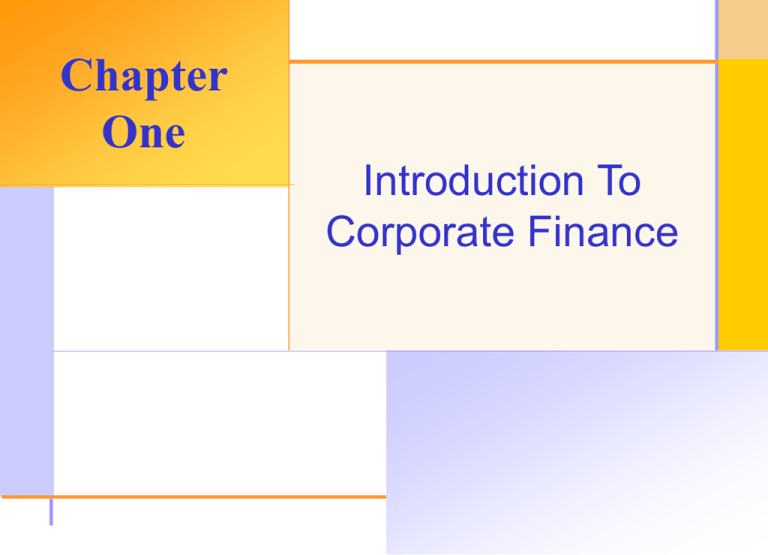
Chapter
One
Introduction To
Corporate Finance
© 2003 The McGraw-Hill Companies, Inc. All rights reserved.
Key Concepts and Skills
• Know the basic types of financial management
decisions and the role of the financial manager
• Know the financial implications of the different forms
of business organization
• Know the goal of financial management
• Understand the conflicts of interest that can arise
between owners and managers
• Understand the various types of financial markets and
financial institutions
• Understand current trends in Canadian financial markets
© 2005 McGraw-Hill Ryerson Limited
Chapter Outline
•
•
•
•
•
•
•
Corporate Finance and the Financial Manager
Forms of Business Organization
The Goal of Financial Management
The Agency Problem and Control of the
Corporation
Financial Markets and the Corporation
Financial Institutions
Trends in Financial Markets and Financial
Management
© 2005 McGraw-Hill Ryerson Limited
Areas of Financial Management
•
Corporate Finance
•
Investments
•
Financial Institutions
•
International Finance
© 2005 McGraw-Hill Ryerson Limited
Financial Management Decisions
•
•
•
Capital budgeting: What long-term
investments should the firm undertake? (fixed
assets)
Capital Structure: What is the best way to
raise long-term financing for these
investments? (long-term debt and equity)
Net Working Capital: How should the firm
manage its short-term assets and liabilities
(i.e., manage the day-to-day finances)? (shorttem assets and liabilities)
© 2005 McGraw-Hill Ryerson Limited
Financial Manager
• Shareholders are the owners of the firm.
• In large firms, shareholders are not involved in
the day-to-day operations. Managers are
employed as agents of the shareholders to make
decisions on their behalf.
• The treasurer and controller share financial
functions of the firm and they report to the top
financial manager within the firm who is
usually the Chief Financial Officer (CFO).
© 2005 McGraw-Hill Ryerson Limited
Forms of Business Organization
• Most of what we do in class is described using the publicly
traded manufacturing corporation as the setting. It is
important to keep in mind that other forms of organization
exist as well.
• Three major business forms in Canada
– Sole proprietorship
– Partnership
• General
• Limited
– Corporation
• In other countries, corporations are also called joint
stock companies, public limited companies and limited
liability companies
© 2005 McGraw-Hill Ryerson Limited
Sole Proprietorship
Unincorporated business owned by one individual
• Disadvantages
• Advantages
– Easiest to start
– Least regulated
– Single owner keeps all
the profits
– Profits are taxed once
as personal income
– Unlimited liability
– Limited to life of
owner
– Equity capital limited
to owner’s personal
wealth (difficulty in
raising capital)
– Difficult to sell
ownership interest
© 2005 McGraw-Hill Ryerson Limited
Partnership
Unincorporated business owned by two or more
people
• Advantages
• Disadvantages
– Few government
regulations
– More capital available
(since there are two or
more owners)
– Relatively easy to start
– Profits taxed once as
personal income
– Unlimited personal
liability
– Partnership dissolves
when one partner dies or
wishes to sell (i.e.,
limited life)
– Difficult to transfer
ownership
© 2005 McGraw-Hill Ryerson Limited
Partnership types
• General Partnership: All partners share. All have
unlimited liability.
• Limited Partnership: General partners run
business; have unlimited liability. Limited
partners are silent on operations and have
limited liability.
© 2005 McGraw-Hill Ryerson Limited
Corporation
• A legal entity that is separate and distinct from
its owners and managers. Many owners
indirectly operate the firm through the board of
directors. Owners are not involved in the day to
day operations, but are frequently asked to vote
on major decisions, such as, dividend changes,
election of new directors, issuance of new stock,
etc.
© 2005 McGraw-Hill Ryerson Limited
Corporation
• Advantages
– Limited liability
– Unlimited life
– Management
specialization allows
for increased
efficiency
– Ownership is easily
transferred
– Easier to raise capital
– No limit on size
• Disadvantages
– Agency problems due to
separation of ownership
and management
– Double taxation (profits
are taxed at the corporate
level and then dividends
are taxed at the personal
level)
– Much government
regulation
– High organization costs
© 2005 McGraw-Hill Ryerson Limited
Goals of Financial Management
– Maximize shareholder wealth
– Maximize share price
– Maximize firm value
• Stock price depends on: earning per share
(EPS), level of economic activity, corporate
taxes, dividends, and debt versus equity
financing.
© 2005 McGraw-Hill Ryerson Limited
The Agency Problem
• There is a potential conflict of interest between
the agent (manager) hired by the principal
(stockholder) to represent the principal’s
interest.
• Stockholders want stock price maximization
• Managers want perquisites and job security
© 2005 McGraw-Hill Ryerson Limited
Managing the agency problem
•
•
•
Managerial compensation (incentives can be
used to align management and stockholder
interests by linking compensation to
performance).
Corporate control (threat of takeover).
Direct intervention by stakeholders
(stakeholders include shareholders, creditors,
employees, customers, suppliers and the
federal and provincial governments).
© 2005 McGraw-Hill Ryerson Limited
Financial Markets and the Corporation
• Financial markets are markets in which those with
surplus funds (households) meet with those that
need funds (corporation).
© 2005 McGraw-Hill Ryerson Limited
Types of Financial Markets
• Money versus capital markets:
- Money markets are financial markets where
short-term debt securities are bought and sold.
- Capital markets are financial markets where
long-term debt and shares of stock are traded.
© 2005 McGraw-Hill Ryerson Limited
Types of Financial Markets
• Primary versus secondary markets:
• Primary markets: when a firm first issues a
security, the sale takes place in the primary
market. These transactions maybe either public
offerings or private placements.
• Secondary markets: security trades after the
initial public offering take place in secondary
markets.
© 2005 McGraw-Hill Ryerson Limited
Types of Financial Markets
• Dealer versus auction markets:
• Dealer markets have no physical location.
Bonds (debt securities) usually trade in dealer
markets.
• Auction markets have a physical location (an
exchange) where trading takes place on the
floor of the exchange (e.g., TSX).
© 2005 McGraw-Hill Ryerson Limited
Cash Flows to and from the Firm
© 2005 McGraw-Hill Ryerson Limited
Financial Institutions
• Financial institutions act as intermediaries
between suppliers and users of funds
• Institutions earn income on services provided:
– Indirect finance – Earn interest on the spread
between loans and deposits
– Direct finance – Service fees (i.e. bankers
acceptance and stamping fees)
© 2005 McGraw-Hill Ryerson Limited
Trends in Financial Markets and Management
• Financial Engineering
• Derivative Securities
• Advances in Technology – i.e. E-business
• Deregulation
• Corporate Governance Reform
© 2005 McGraw-Hill Ryerson Limited
Quick Quiz
• What are the three types of financial
management decisions and what questions are
they designed to answer?
• What are the three major forms of business
organization?
• What is the goal of financial management?
• What are agency problems and why do they
exist within a corporation?
• What is the difference between a primary
market and a secondary market?
© 2005 McGraw-Hill Ryerson Limited
Summary
• You should know:
– The advantages and disadvantages between a sole
proprietorship, partnership and corporation
– The primary goal of the firm
– What an agency relationship and cost are
– The role of financial markets
© 2005 McGraw-Hill Ryerson Limited



